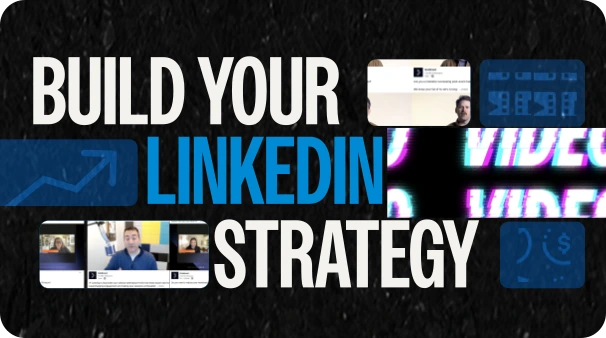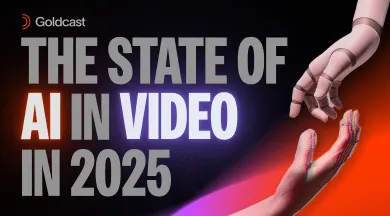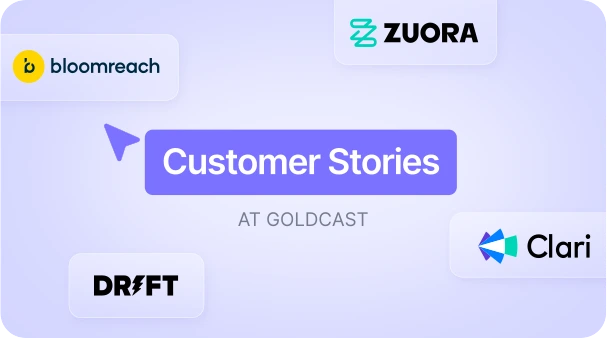How to Improve Organic Search Results with Video: Tips and Strategies
Table of Contents
Maximize Your Marketing ROI
Join 10,000 other marketers already getting the best tips on running engaging events that boost pipeline and create raving fans.
B2B marketing has changed. And the world of search engine optimization (SEO) has changed right along with it.
From Google’s epic Experience, Expertise, Authoritativeness, and Trustworthiness (E-E-A-T) update in late 2022 to ongoing speculation about the role of AI Overviews (AIOs), it can feel like there are more questions than answers when it comes to SEO.
But there’s one thing we know for sure. If you want to dominate the search engine results page (SERP) with attention-grabbing features like snippets, media packs, and AIO, you’ve got to have video in the mix.
Videos are proven to improve organic search ranking, traffic, and even conversions. To capture every opportunity your videos have to offer, start with these proven strategies for using videos to improve SEO.
Do videos improve SEO?
Videos not only improve SEO, data shows that they can also help increase conversions. Adding videos to your blog posts and landing pages not only boosts the organic traffic to that page, videos can also rank independently of their parent content to deliver multiple brand touchpoints and traffic streams.
How does video content affect SEO?
Video brings a host of benefits for B2B marketers, including increased organic search performance, clickthrough rates (CTRs) and lead count. Here are a few of the top SEO strategies and advantages video can deliver.
1. Improve dwell time and engagement
Love it or hate it, things have changed in the post Google Analytics 4 [GA4] era. The extent to which Google uses click data in its ranking algorithms is up for debate and, in their own words, a “huge mess”. But according to a recent analysis from iPullRank, long clicks are a measure of the success of a search session, just like dwell time.
By offering visitors the opportunity to both click and stay a while, videos help send the right kinds of signals to search engines, including a positive impact on your bounce rates. Here’s iPullRank: “The evidence is fairly definitive, there can be little doubt that Google uses clicks and post-click behavior as part of its ranking algorithms.”
2. Increase CTRs with rich snippets and thumbnails
According to research from BrightEdge, in some SERP positions, the CTR is 50% higher when a video thumbnail is included. By adding a visual element to your website’s SEO, you boost your chances of winning the snippet, while attracting more attention (and clicks!) compared to text-only results.
This increased engagement and CTR sends a positive signal to search engines that your page is relevant to users' queries, leading to improved rankings and domain authority. While it’s still not clear exactly how AIOs will impact your current snippet positions and CTRs, early analyses by experts like growth advisor Kevin Indig indicate a strong relationship between a domain’s organic rankings and AIO citations.
Just make sure you and/or your SEO team are on the ball with your video sitemap and schema markup.
3. Boost your backlink profile
Pages with embedded videos may also be more likely to attract backlinks from other websites due to the shareable nature of video content. According to a Backlinko analysis of 11.8 million Google search results, the #1 result in Google has an average of 3.8x more backlinks than positions 2-10.
If a dedicated video SEO strategy is part of your broader SEO efforts, you can create a virtuous cycle of link building by linking back to your YouTube videos in your text-based content and web pages, and including links back to your text-based content and website in your YouTube video descriptions.
With plenty of valuable video content available via YouTube, Google video mode, text, image and video search, you’ll also be more likely to attract external links from other brands and websites that find your content helpful.
4. Provide the ultimate mobile experience
When was the last time you watched a video on your mobile phone? This morning, last night, five minutes ago? As of early 2023, nearly 70% of the digital video content audience in the US was watching videos on their smartphones.
Providing a seamless video viewing experience on mobile devices was crucial before the rise of video. And it’s even more important now. Websites that offer mobile-optimized video content may see higher user engagement and longer on-page dwell times, both of which are positive signals for search algorithms.
5. Sharing on social media
Sharing video content on social media platforms can lead to increased visibility, brand awareness, and referral traffic. While the direct impact of social signals on SEO rankings is debatable, the overall buzz and attention generated by social sharing could indirectly contribute to improved SEO performance through increased brand mentions and link acquisition.
Dos and don’ts of video marketing for SEO
Now that you’ve got a few ideas for how to use video to level up your SEO, let’s take a look at some of the dos and don’ts every B2B marketer should know about.
The dos
The following practices will help you execute an effective video marketing strategy that drives more organic search results for your brand.
Align the length of the video to your audience
According to Wistia’s 2024 State of Video report, longer videos get more clicks per page visit: 58% of visitors are more likely to click a 60+ minute video, and 50% will click a 30-60 minute video.
They also found that videos that run over 5 minutes often have higher conversion rates. But it’s important to keep the visitor’s experience top of mind. For example, adding 1-3 minute video highlights to a blog post can encourage visitors to interact with your content, without requiring them to spend time they probably don’t have.
Create multiple types of content
45% of the companies surveyed by Wistia said they want to create more videos to showcase their products and expertise this year.
If you have a long-form video series, like a podcast or webinar series in place, those events and recordings can be excellent source material for a range of video content types. Repurpose them into smaller snippets, hot takes and highlight reels to create content that’s engaging, educational and/or product-led.
Add captions and transcripts
According to data, captions boost viewer affinity by 95%, recall by 58%, likability by 31%, and uniqueness by 25%. With the rise in AI tools that can automatically generate captions and video transcripts for you in a fraction of the time, there’s no excuse for not offering these accessibility features for your audience.
Embed YouTube videos in your website content
Today a whopping 77% of marketers use YouTube to host videos. When you upload your videos to YouTube, they’re indexed by YouTube’s algorithm—not Google’s.
The impact of that extra layer of optimization from YouTube to your website may not be easy to measure directly, but SEO experts believe it does influence rankings.
Don’ts of video marketing for SEO
So what are some of the common mistakes with video for SEO? Here’s what not to do.
Add videos that don’t satisfy intent
As with your text-based content, make sure your video content aligns with your audience’s search intent. Viewers get annoyed when they don’t get what they came for. Instead of popping in any old video that’s available, consider repurposing a long-form video into a short-form answer that aligns with the user’s search intent.
Forget to optimize for all video hosting platforms
Whether you’re hosting your video content on your own site, a third-party site like Vimeo or YouTube, or both, make sure you’re clear on the latest technical and SEO requirements of each platform.
Use your iPhone camera
Don’t get us wrong: authenticity is key to a successful video strategy. But with the amount of video content that floods the internet every day, viewers are more discerning than they used to be.
Start with strong production quality and take time to put the professional polish on your videos by adding captions, logos, and branded CTAs.
How events can help fuel your organic traffic from video
Events center on real conversations with real people. They’re authentic, engaging and when done with pro-level production quality—they’re also an excellent source of video content.
If you’re already running webinars, digital events, or podcasts as part of your B2B marketing strategy, you can use the engagement data from those assets to fuel your video strategy.
Here are a few B2B brands that have done exactly that:
Get more engagement in less time
By using the AI in Content Lab to repurpose they’re event recording, the marketing team at AspenCore save two hours of production time per post-event video snippet.
And get this: a single video repurposed from their events generated more engagement than a 39-post campaign with only graphics.
“The engagement from one post versus an entire campaign was incredible. We also got a lot of re-shares and whatnot,” says Kristen Nuñez, Global Event Manager at AspenCore. “Before I felt like I was very out of my league. But now I feel like it makes it so easy. It doesn't make me feel like I'm video editing now, I just feel like I'm putting together a portion of my event and it doesn't seem like I'm doing something out of my wheelhouse.”
Here’s how Kristen explains the process:
Publish branded videos faster
Before refining their repurposing process, the expert marketers at Qualio spent 2-5 hours editing per each hour of event content.
Senior Content Marketing Manager, Alex Pavlović says the entire process now takes five minutes—a 6x increase in speed. And the best part is, each one is fully optimized with the right technical requirements for each platform, plus custom branded templates with Qualio’s unique logos and fonts.
“I watched the clips half expecting them not to be great, but they didn’t need anything else from me. And I could quickly add an opening and closing and branded footage to bookmark it,” says Alex.
Here’s Alex:
Distribute video content across multiple channels
The team at SnapLogic knew they wanted to uplevel their post-webinar content creation, but the process was just too clunky to scale.
“It used to take us weeks to find ways to repurpose our event content,” says Davi Schmidt, Director of Demand Generation at SnapLogic. “Now we’re doing that in minutes across social, blogs, videos, emails. I love Content Lab. It’s my new favorite feature.”
After upgrading their process with Content Lab, they went from 1-2 pieces to 7+ pieces of post-webinar content. With a steady stream of video content, they now have relevant videos for every channel from TikTok, to LinkedIn, and beyond.
Here’s how Davi sees it:
Great SEO requires great video
As the noise around SEO gets louder, the importance of offering value in your content becomes even more critical than it already is.
As a B2B marketer, using videos for SEO can help strengthen your search performance and position your brand for peak visibility in the SERP—no matter what moves Google makes next.
And your events are the perfect place to start. Fuel your multi-channel strategy with high quality video content. Try Content Lab today.
Not already a Goldcast user? Book a demo of Goldcast and learn how to make your next digital event or webinar, your best yet.
Stay In Touch
Platform
Resources
Company
Community
© 2025 Copyright Goldcast, Inc. All rights reserved.



 Upcoming Events
Upcoming Events Event Series
Event Series On-Demand Events
On-Demand Events

